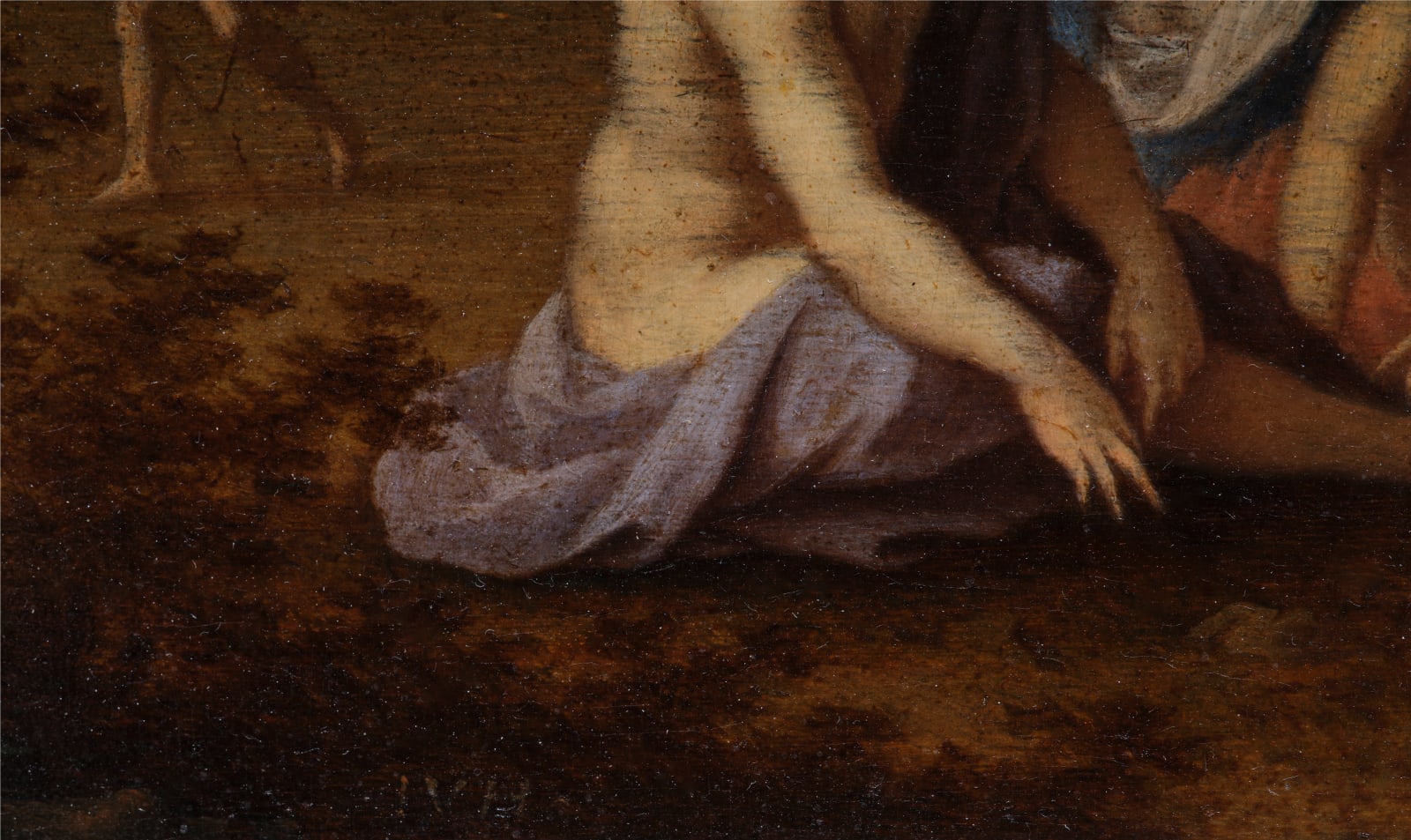 Jan van Haensbergen - The Bath of the Nymphs - Mauritshuis - The Hague - Netherlands
Jan van Haensbergen - The Bath of the Nymphs - Mauritshuis - The Hague - Netherlands
 Attributed to Jan van Haensbergen - The Bathers (Inv. 2639) - Royal Museums of Belgium
Attributed to Jan van Haensbergen - The Bathers (Inv. 2639) - Royal Museums of Belgium
Jan van Haensbergen Dutch school, 1642-1705
21.5 x 27.5 cm
Further images
Jan van Haensbergen was a painter of the Dutch Golden Age and a pupil of Cornelius van Poelenburgh (Utrecht 1594 - 1667). The painting we are presenting is inspired by Poelenburgh’s landscapes from his Italian sojourn. The dreamlike atmosphere of this Gathering in antique ruins appealed to us. Against a backdrop of antique ruins, three draped characters (perhaps bathers) are sitting in a circle, greeting a fourth character walking towards them.
Their tranquility contrasts with the bustle of the other characters in the background. They constitute a vivid illustration of otium, this leisure time that allows us to realize our full potential. With this Arcadian landscape, Jan van Haensbergen invites us in turn to leave the hustle and bustle of everyday life behind, to take a break, to enjoy the present moment chatting with close friends…
1. Jan van Haensbergen, a landscape and portrait painter of the Dutch Golden Age
Jan van Haensbergen was born in 1642 in Gorinchem, a town in southern Holland to the east of Rotterdam. He was a pupil of Cornelius van Poelenburgh, and began by painting landscapes inspired by those of his master, in an Italianate style. Between 1668 and 1669, he was registered at the Guild of Saint Luke in Utrecht.
In 1669, he moved to The Hague, where he joined the Confrérie Pictura, an artist society founded in 1656. His portraits, which became his main activity as a painter after settling in The Hague, were strongly influenced by Caspar Netscher (Prague or Heidelberg 1639 - The Hague 1684), whom he met in The Hague and whose son Constantijn became his son-in-law by marrying his daughter Magdalena.
In addition to his work as an artist, Van Haensbergen was also an art dealer, probably helped by his appointment as Dean of the Confrérie Pictura, where he also teached.
2. Description of the artwork and related paintings
This painting seems to us to be a kind of allegory of otium, that quiet bliss promised by Epicurus. It might even evoke an Epicurean proverb: "It is better to lie on the naked ground and be at ease, than to have a golden carriage and a rich table and be worried"[1].
Three draped young people - two men and a woman in the background - are seated in a circle, greeting a fourth figure walking towards them, hair disheveled and body draped in a towel as if drying off after a bath, indicating the need for prior purification to fully enjoy this rest. Their nonchalance contrasts with the bustle of the various characters in the background.
The composition is punctuated by successive diagonals, and opens onto a landscape on the right, with a succession of mountainous planes. This painting is typical of the Italianate works produced by Van Haensbergen in the 1660s under the influence of Cornelis van Poelenburgh (without ever visiting Italy himself). A comparison with the Bath of the Nymphs from the Mauritshuis in The Hague, dated 1665, leads us to believe that our painting is probably a later one, as the composition appears to be more structured than the one of the Mauritshuis painting, revealing the work of a seasoned painter.
Another painting with a similar subject attributed to Jan van Haensbergen (and formerly to Cornelis van Poelenburgh) is held in the Royal Museums of Belgium.
3. Provenance and framing
This drawing comes from the personal collection of dealer and expert Paul Touzet (1898 - 1981). Between the wars, he opened his first gallery on rue de l'Université in Paris. He then moved to rue des Beaux-Arts, where he was exhibiting mainly Dutch and Flemish paintings. In the 1960s, his main activity became expertise during public auctions, and he remained one of the most renowned experts in Paris until his death in 1981.
To frame this painting, we have chosen an Italian gilded and painted wood frame from the 17th century. Its warm gilding echoes the ochre colors of our painting, while the black highlights evoke the Dutch frames.
[1] Quoted in Thomas G. Rosenmeyer (1973). The green cabinet: Theocritus and the European pastoral lyric. Berkeley: University of California Press page 65












